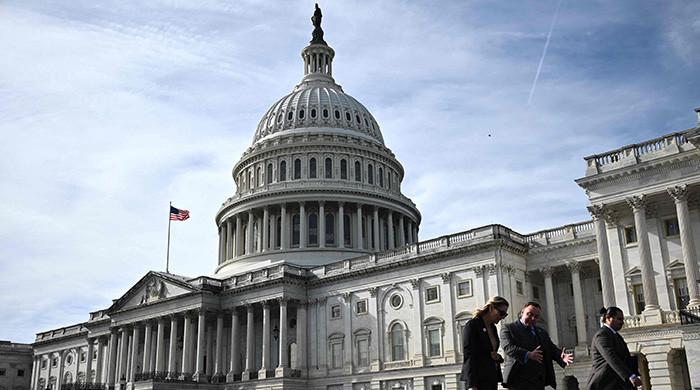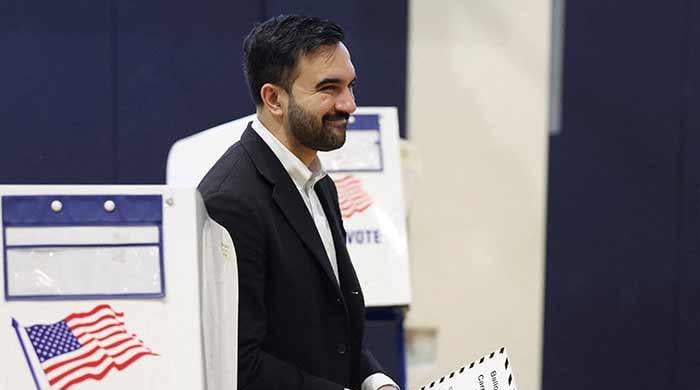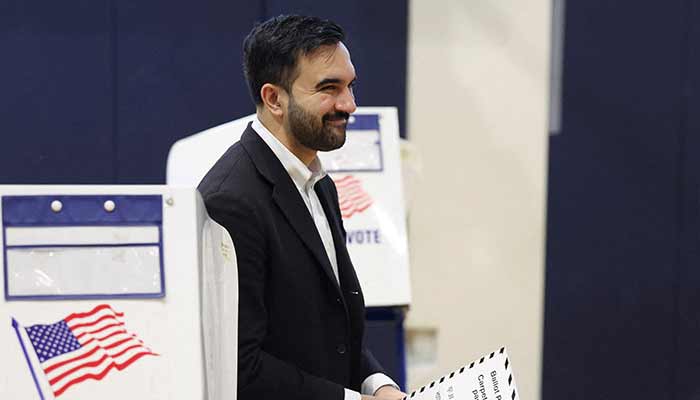Politics
Saudi Crown Prince MBS will visit US president on Nov 18, says White House official


- Saudis hesitant to join in absence of steps for Palestinian statehood.
- Trump hopeful for Saudis to ultimately join Abraham Accords.
- Trump and MBS may also discuss a US-Saudi defence agreement.
WASHINGTON: Saudi Arabia’s Crown Prince Mohammed bin Salman will be at the White House on November 18 for an official working visit with US President Donald Trump, a White House official said on Monday.
The visit comes as Trump pushes Saudi Arabia to join the list of nations that have joined the Abraham Accords. In 2020, Trump reached deals with United Arab Emirates, Bahrain, Sudan and Morocco to normalise relations with Israel.
The Saudis have been hesitant to join in the absence of steps toward Palestinian statehood.
Trump told CBS’ “60 Minutes” in an interview broadcast on Sunday that he believed the Saudis would ultimately join the accords.
Trump and bin Salman may also discuss a US-Saudi defence agreement. The Financial Times reported two weeks ago that there were hopes the two countries could sign such an agreement during bin Salman’s visit.
A senior Trump administration official told Reuters that “there are discussions about signing something when the crown prince comes, but details are in flux.”
The Saudis have sought formal US guarantees to defend the kingdom as well as access to more advanced US weaponry.
Saudi Arabia is one of the largest customers for US arms, and the two countries have maintained strong ties for decades based on an arrangement in which the kingdom delivers oil and Washington provides security.
During Trump’s visit to Riyadh in May, the United States agreed to sell Saudi Arabia an arms package worth nearly $142 billion.
Politics
US govt shutdown ties record for longest in history


The US government shutdown entered its 35th day on Tuesday, matching a record set during President Donald Trump’s first term, as lawmakers voiced optimism over progress behind the scenes to end the dispute.
The federal closure appears almost certain to become the longest in history, with no major breakthroughs expected before it goes into its sixth week at midnight — although there were fragile signs in Congress that an off-ramp is closer than ever.
Senate Majority Leader John Thune set the buoyant mood music on Monday when he told reporters he felt “optimistic” that newly energised talks between warring Republicans and Democrats could end in a deal before next week.
The government has been grinding to a halt since Congress failed to approve funding past September 30, and pain has been mounting as programmes — including food aid relied on by millions of Americans — hang in limbo.
“I’ll be honest with you, I don’t think any of us expected that it would drag on this long. We didn’t believe, we couldn’t have imagined,” House Speaker Mike Johnson told a news conference arranged to mark the six-week milestone.
“It’s now tied for the longest shutdown in US history. And we didn’t think we’d have to come in here every single day — day after day after day — and repeat the obvious facts to the American people and to put on display every day what is happening here.”
Some 1.4 million federal workers — from air traffic controllers to park wardens — have been placed on enforced leave without pay or made to work for nothing, while vital welfare programs and even paychecks for active-duty troops are under threat.
Some lawmakers — including Thune and Johnson — are hoping a slew of elections taking place in New York, Virginia, New Jersey and California on Tuesday will provide the momentum they need to reopen the government.
But both sides remain dug in over the main sticking point — health care spending.
Democrats say they will only provide votes to end the funding lapse after a deal has been struck to extend expiring insurance subsidies that make health care affordable for millions of Americans.
But Republicans insist they will only address health care once Democrats have voted to switch the lights back on in Washington.
While both sides’ leadership have shown little appetite for compromise, there have been signs of life on the back benches, with a handful of moderate Democrats working to find an escape hatch.
A separate bipartisan group of four centrist House members unveiled a compromise framework Monday for lowering health insurance costs.
Democrats believe that millions of Americans seeing skyrocketing premiums as they enroll onto health insurance programs for next year will pressure Republicans into seeking compromise.
But Trump has held firm on refusing to negotiate, telling CBS News in an interview broadcast Sunday that he would “not be extorted.”
The president has sought to apply his own pressure to force Democrats to cave, by threatening mass layoffs of federal workers and using the shutdown to target progressive priorities.
Last week his administration threatened to cut off a vital aid program that helps 42 million Americans pay for groceries for the first time in its more than 60-year history, before the move was blocked by two courts.
But Trump nevertheless insisted Tuesday — in apparent defiance of the court orders — that the food aid would be disbursed only after the government shutdown ends.
Trump announced on his Truth Social platform that benefits from the SNAP program “will be given only when the Radical Left Democrats open up government, which they can easily do, and not before!”
Trump also revived his call for the elimination of the Senate filibuster — the 60-vote threshold for passing most legislation — so Republicans can pass government funding without the help of Democrats.
Politics
‘On brink of making history’, says Mamdani after voting in New York mayoral race


- New Yorkers on verge of saying goodbye to politics of past: Mamdani.
- Democratic nominee on about 44% in latest polls, ahead of others.
- “Will utilise every single tool to fight for people of New York.”
Democratic nominee Zohran Mamdani on Tuesday said New York City was “on the brink of making history” as he cast his vote in the city’s mayoral election, expressing confidence that his progressive campaign was poised to deliver a break from what he described as “the politics of the past.”
Speaking to reporters outside a high school polling station in Astoria, Queens, the 34-year-old democratic socialist appeared optimistic about his chances.
“We are on the brink of making history in our city, on the brink of saying goodbye to a politics of the past,” he said. “I believe that victory is a mandate in and of itself.”
Polls were opened at 6am (1100 GMT) and will close at 9pm, while early voting, which wrapped up Sunday, saw more than 735,000 people cast ballots according to election officials, the highest ever number.
Mamdani was at about 44% in latest polls, several points ahead of former state governor Andrew Cuomo, who is running as an independent.

The democratic nominee, aged just 34, is a self-described socialist who was virtually unknown before his upset victory to secure the Democratic nomination.
He has focused on reducing living costs for ordinary New Yorkers, building support through his informal personal style and social-media-friendly clips of him walking the streets chatting with voters.
Mamdani, a State Assembly member, is facing Cuomo, 67, who is running as an independent after losing to Mamdani in the primary. Republican nominee Curtis Sliwa, 71, is trailing far behind in most opinion polls, which have consistently shown Mamdani with a comfortable lead.
However, the contest has taken on national political overtones in recent days. Unabashedly playing the race card, President Trump on Tuesday smeared Mamdani, who would be New York’s first Muslim mayor, as a “Jew hater.”
“Any Jewish person that votes for Zohran Mamdani, a proven and self-professed JEW HATER, is a stupid person!!!” the Republican president posted on his social media platform.

Trump had also warned of blocking federal funds to the city if Mamdani became mayor.
Responding to Trump’s remarks, Mamdani said he would “not be intimidated.” “What we see in the language of Donald Trump is a premise as if it is his decision on whether or not to fund this city — the very money this city is owed,” he said.
“I look forward to utilising every single tool at my disposal as the next mayor to fight for the people of this city. I will not be intimidated by this president, or anyone.”
He downplayed some polls suggesting he may not have the support of the majority of New Yorkers, saying, “I believe that victory is a mandate in and of itself.”
‘A mayor for all New Yorkers’
“I voted for Mamdani,” said 36-year-old Gregory Jones told Reuters.
“As somebody who’s been living in New York City for over 10 years — affordability, safety, making New York feel like home for so many people who’ve been living here for decades, for all New Yorkers, for working families, for business people, for immigrants, for underrepresented people.
“It’s really important that we have a mayor that represents all types of New Yorkers and makes New York a place where everyone can thrive and work and live happily, healthily and safely,” he added.

Lucy Cordero, a 68-year-old from Mott Haven Bronx, says she voted for Mamdani “because he’s new and he’s fresh”.
“Maybe he can make a change and fix what’s messed up now,” she told Al Jazeera.
Denise Gibbs, 46, a doctor of physiotherapy, voted at a school in Brooklyn.
“I sure hope it improves the city. I want to see it decrease divisiveness and increase livelihoods of working-class households and services for children,” she said, wearing green scrubs.
Politics
Afghans dig through rubble after earthquake kills at least 27


- Quake leaves almost 1,000 injured, destroys several buildings.
- Poor infrastructure causes “immense” difficulties in rescue: official.
- China offers aid after UN pledged assistance for Afghanistan.
Residents of northern Afghanistan were sifting through rubble and treating their injured on Tuesday after a powerful 6.3-magnitude earthquake left at least 27 dead and destroyed hundreds of houses.
The quake struck near the northern Afghan city of Mazar-i-Sharif early on Monday, injuring almost 1,000 and damaging the city’s historic Blue Mosque, authorities said. The sparsely populated epicentre meant the death toll was lower than initially feared.
Hundreds of houses were either completely or partially destroyed, according to the Afghanistan National Disaster Management Authority (ANDMA). Aid groups said the figure was concerning just ahead of the Afghan winter, when temperatures drop below freezing.
Relief workers facing ‘immense’ difficulties
The difficulties for relief workers due to poor road conditions and other infrastructure issues are “immense”, said Hosam Faysal, Head of Delegation for Afghanistan at the International Federation of Red Cross and Red Crescent Societies.
“Winter is already completely contributing to the complexity of the situation,” Faysal told journalists in Geneva via video link from Kabul.
Several health facilities have been damaged in the quake, adding to the challenges, Christian Lindmeier, a spokesperson for the World Health Organisation, told the briefing.
Some 956 people have been injured, according to Afghanistan’s Ministry of Public Health.
Buildings at risk of collapse
On Tuesday, residents in Tangi Tashqurgan, an area close to the quake epicentre, were digging out rubble and reinforcing affected buildings.
Mohammad Yasin, a local shopkeeper, said dozens of structures had been damaged or destroyed in the quake.
“If you go inside the shops, you feel afraid they might collapse any moment,” he said.
The disaster is the latest challenge for Afghanistan’s Taliban administration, already grappling with crises including an earthquake in August that killed thousands in the east of the country, a sharp drop in foreign aid and mass deportations of Afghan refugees by neighbouring countries.
The United Nations has pledged assistance along with India, which is seeking to thaw ties with a Taliban government in Afghanistan that is still under sanctions from many Western nations. China said on Tuesday it would also offer aid.
Earthquakes kill hundreds every year in Afghanistan
Hemmed in by rugged mountains, Afghanistan is prone to a range of natural disasters, but its earthquakes are the most deadly, killing about 560 people on average each year and causing annual damage estimated at $80 million.
Rudimentary building techniques contribute to the casualty figures, with experts recommending new structures be built in an earthquake-resistant way and existing buildings be retrofitted to reduce the chances of collapse.
A relatively higher standard of building, comparatively flatter terrain and a lower population meant Monday’s death toll was considerably lower than that of the August quake, said ANDMA spokesperson Yousuf Hammad.
-

 Tech1 week ago
Tech1 week agoOpenAI says a million ChatGPT users talk about suicide
-

 Tech7 days ago
Tech7 days agoHow digital technologies can support a circular economy
-

 Tech7 days ago
Tech7 days agoUS Ralph Lauren partners with Microsoft for AI shopping experience
-

 Tech7 days ago
Tech7 days agoAI chatbots are becoming everyday tools for mundane tasks, use data shows
-

 Sports7 days ago
Sports7 days agoBilly Bob Thornton dishes on Cowboys owner Jerry Jones’ acting prowess after ‘Landman’ cameo
-

 Fashion1 week ago
Fashion1 week agoJapan’s textile trade shows strong apparel demand, weak yarn imports
-

 Fashion1 week ago
Fashion1 week agoTaiwan Textile Select showcases sustainable innovation at TITAS 2025
-

 Tech1 week ago
Tech1 week agoHere’s How Many People May Use ChatGPT During a Mental Health Crisis Each Week






